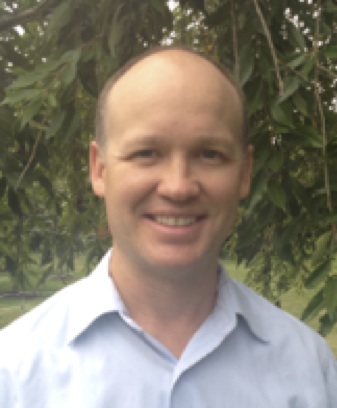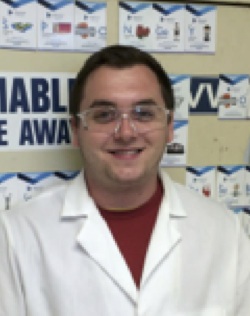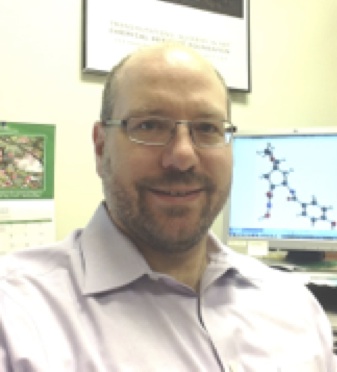Org. Synth. 2016, 93, 272-285
DOI: 10.15227/orgsyn.093.0272
Synthesis of α-Carboline
Submitted by Linli He, Shawn P. Allwein, Benjamin J. Dugan, Kyle W. Knouse, Gregory R. Ott, and Craig A. Zificsak
*1
Checked by Kevin Kou and Richmond Sarpong
1. Procedure
A.
3-Chloro-N-phenyl-pyridin-2-amine (1). An air-dried, 1-L, three-necked, round-bottomed flask is equipped with a Teflon-coated, egg-shaped, magnetic stirring bar (1/2"x 5/8"), rubber septum, air-jacketed condenser with nitrogen inlet and thermometer (Figure 1). The flask is evacuated (20 mmHg), backfilled with
nitrogen, then charged with
2,3-dichloropyridine (30.0 g, 203 mmol, 1.0 equiv) (
Note 1),
palladium(II) acetate (1.14 g, 5.08 mmol, 0.025 equiv),
triphenylphosphine (3.99 g, 15.2 mmol, 0.075 equiv) and
sodium tert-butoxide (29.9 g, 311 mmol, 1.53 equiv).
Figure 1. Reaction Setup: Steps A and B
The septum is replaced and
toluene (210 mL) is added via syringe, the resulting light brown solution is stirred for 10 min before
aniline (20.0 mL, 219 mmol, 1.05 equiv) is added via syringe in one portion. The resulting dark brown mixture is heated to 100 °C in a heating mantle over 20 min and stirred for 16 h (
Note 2). The reaction is cooled to 0 °C in an ice bath and 2 M
HCl (300 mL) is added. The ice bath is removed and the mixture is stirred for 10 min at room temperature before filtering through a pad of Celite 545 (15 g) in a 350-mL, medium-porosity, fritted funnel. The filtrate is poured into a 1-L separatory funnel, the layers are separated, and the organic phase is further extracted with 2 M
HCl (2 x 50 mL). The combined acidic extracts are cooled to 0 °C in an ice bath and
dichloromethane (100 mL) is added. The biphasic solution is then treated with 19 M
NaOH (50 mL) and transferred to a 1-L separatory funnel. The phases are separated and the aqueous phase is further extracted with
dichloromethane (3 x 50 mL). The combined organic extracts are dried over
sodium sulfate (10 g) for 10 min, diluted with
hexane (250 mL), then filtered through a pad of silica gel (90 g) (
Note 3), rinsing with dichloromethane:hexane (1:1, 500 mL) (Figure 2). The filtrate is collected into two 1-L flasks. The first 500 mL fraction is colorless and the second 500 mL fraction has a subtle tint of yellow (Figure 3). Both fractions were concentrated to give a yellow liquid.
1H NMR analyses of both fractions were identical; therefore the two fractions were combined to give 34.5 g (82%) of
3-chloro-N-phenyl-pyridin-2-amine as a yellow liquid, which formed beige crystals when cooled in a -20 °C freezer (Notes
4 and
5).
Figure 2. Filtration through silica gel
Figure 3. Fractions 1 and 2 following filtration through silica gel
B.
α-Carboline (2). An air-dried, 1-L, three-necked, round-bottomed flask is equipped with a Teflon-coated, egg-shaped, magnetic stirring bar (1/2"x 5/8"), rubber septum, air condenser with
nitrogen inlet and thermometer (Figure 1). The flask is evacuated with high vacuum, backfilled with
nitrogen then charged with
3-chloro-N-phenyl-pyridin-2-amine (35.0 g, 171 mmol, 1.0 equiv),
palladium(II) acetate (0.96 g, 4.3 mmol, 0.025 equiv), and
triphenylphosphine (3.36 g, 12.8 mmol, 0.075 equiv). The septum is replaced and
N,N-dimethylformamide (150 mL) is added via syringe. The resulting solution is stirred for 10 min before
1,8-diazabicyclo[5.4.0]undec-7-ene (52.0 mL, 52.9 g, 348 mmol, 2.0 equiv) is added via syringe (
Note 6). The resulting dark amber solution is heated to 130 °C in a heating mantle over 25 min and stirred for 48 h (
Note 7). The reaction is cooled to room temperature and filtered through a sintered glass funnel into a 2-L round-bottomed flask, equipped with a Teflon-coated, egg-shaped, magnetic stirring bar (1/2"x5/8"). The sintered glass funnel is replaced with an addition funnel and water (850 mL) is added over 25 min with stirring (exothermic).
Figure 4. Golden yellow suspension after precipitation with water
The golden yellow suspension (Figure 4) is stirred for 30 min before the solids are collected in a Büchner funnel. The flask and solids are washed with
N,N-dimethylformamide/water (1:3, 100 mL) followed by water (600 mL). The yellow solids are dried in a vacuum desiccator for 1 h, transferred to a 1-L Erlenmeyer flask equipped with a Teflon-coated, egg shaped, magnetic stirring bar (1/2"x 5/8"). Acetonitrile (300 mL) is added to the flask and the red suspension is stirred for 15 min at room temperature before the solids are collected in a Büchner funnel. The flask and solids are washed with cold acetonitrile until the filtrate is clear (120 mL). The solids are transferred to a 500-mL round-bottomed flask and dried under vacuum for 16 h to afford
α-carboline as a light green solid (24.9 g, 87% yield) (
Note 8). The isolated solids (24.9 g) are heated in
toluene (700 mL) to an internal temperature of 100 °C in a 1-L Erlenmeyer flask (
Note 9) for 20 min with stirring (
Note 10). The heater and stirrer are turned off and the mixture is gradually cooled to room temperature over 90 min (
Note 11) then chilled in an ice bath for 20 min (
Note 12). The solids are collected by filtration, washed with
toluene (100 mL) and dried on a Büchner funnel and then in vacuo to afford
2 as beige or gray crystals (23.4 g, 81%) (Figure 5) (Notes
13 and
14).
Figure 5. Checker submitted: Left: α-Carboline obtained as fluffy, gray needles after recrystallization (run 1); Right: Fluffy, beige needles after recrystallization (run 2)
2. Notes
1.
2,3-Dichloropyridine (98%, Oakwood Chemical) and
palladium(II) acetate (98%, Strem Chemicals) were used as received.
Triphenylphosphine (99%),
sodium tert-butoxide (98%),
toluene (99.8%, Extra Dry, AcroSeal®) and
aniline (99.8%) were purchased from Acros Organics and used as received.
2. The reaction is monitored by UPLC-MS (Waters Acquity Ultra Performance LC with a Waters Aquity UPLC BEH C18 1.7 µm 2.1x50 mm column paired with a Micromass-ZQ 2000 quadrupole mass spectrometer with electrospray ionization. Solvent A consisted of 0.1% formic acid in 19:1 water:acetonitrile; solvent B consisted of 0.1% formic acid in acetonitrile. The target column temperature was 45 °C, with a run time of two minutes, a flow rate of 0.60 mL/min, and a solvent mixture of 5%A:95%B ramping to 100%B at 1.7 min, holding for 0.6 min. Retention time of 1.38 min for
1.
3. Silica gel (Sorbent Technologies, 40-75 µm particle size, 60Å pore size) was placed into a fritted glass funnel (50 mm diameter) and house vacuum was used to pull the solution through the silica gel.
4.
3-Chloro-N-phenyl-pyridin-2-amine exhibits the following spectroscopic properties:
1H NMR
pdf(500 MHz, DMSO-
d6) δ: 6.82 (dd,
J = 7.7, 4.8 Hz, 1H), 6.98 (app. t,
J = 7.3 Hz, 1H), 7.24-7.32 (m, 2H), 7.65-7.70 (m, 2H), 7.78 (dd,
J = 7.7, 1.5 Hz, 1H), 8.09 (dd,
J = 4.8, 1.5 Hz, 1H), 8.34 (s, 1H);
13C NMR
pdf(125 MHz, DMSO-
d6) δ: 115.5, 115.6, 120.5, 122.0, 128.3, 137.4, 140.4, 145.6, 151.3; IR (neat, ATR): 3400, 3060 (weak), 3031 (weak), 3010 (weak), 1597, 1578, 1515, 1495, 1439, 1402, 1127, 1035, 1028, 779, 754, 741, 690, 545, 504 cm
-1. Anal calcd for C
11H
9N
2Cl: C, 64.56; H, 4.43; N, 13.69. Found: C, 64.49; H, 4.38; N, 13.84. The Checkers determined purity to be 99.7% by quantitative NMR versus an authentic sample of caffeine (99.9% purity, Alfa Aesar) using 24.0 mg of
1 and 24.7 mg of caffeine in DMSO-
d6 (ca. 1.5 mL). mp 49-50 °C. R
f = 0.75 (2:1 hexanes/EtOAc).
5. A second run afforded 36.1 g (87% yield) of
1 as an off-white solid. In this run, the Celite pad was rinsed with 2 M
HCl (2 × 50 mL) and these rinses used to extract the organic layer.
6.
N,
N-Dimethylformamide (99.8%, Extra Dry, AcroSeal®) and
1,8-diazabicyclo[5.4.0]undec-7-ene (98%) were purchased from Acros Organics and used as received.
7. The reaction is monitored by UPLC-MS as specified in
Note 2. Retention time of 0.86 min for
2.
8. Purity was determined to be 98.7% by quantitative NMR versus an authentic sample of caffeine (99.9% purity, Alfa Aesar) using 26.6 mg of
2 and 25.8 mg of caffeine in DMSO-
d6 (ca. 1.5 mL). mp 218-223 °C. A second run afforded 25.2 g (87% yield) as a pale green solid.
9. The flask was wrapped in aluminum foil.
10. The bulk of the solids fully dissolve, but small particles do remain.
11. The Erlenmeyer flask was not removed from the heat plate, but the flask was allowed to gradually cool as the heat plate slowly cooled.
12. An internal temperature of 0 °C is reached.
13.
α-Carboline exhibits the following spectroscopic properties:
1H NMR
pdf(500 MHz, DMSO-
d6) δ: 7.17-7.25 (m, 2H), 7.42-7.48 (m, 1H), 7.51 (d,
J = 8.0 Hz, 1H), 8.15 (d,
J = 7.8 Hz, 1H), 8.41 (dd,
J = 4.8, 1.6 Hz, 1H), 8.49 (dd,
J = 7.7, 1.6 Hz, 1H), 11.80 (s, 1H);
13C NMR
pdf(125 MHz, DMSO-
d6) δ: 111.3, 115.0, 115.2, 119.4, 120.4, 121.2, 126.6, 128.4, 138.8, 146.1, 151.9; IR (film, ATR): 3400, 3129 (weak), 3048 (weak), 2984 (weak), 1597, 1577, 1515, 1494, 1456, 1416, 1403, 1275, 1231, 750, 738, 726, 690, 543 cm
-1. Purity was determined to be 99.9% by quantitative NMR versus an authentic sample of caffeine (99.9% purity, Alfa Aesar.) using 26.6 mg of
2 and 25.8 mg of caffeine in DMSO-
d6 (ca. 1.5 mL). Anal calcd for C
11H
8N
2: C, 78.55; H, 4.79; N, 16.66. Found: C, 78.36; H, 4.61; N, 16.56. mp 217-221 °C. R
f = 0.24 (2:1 hexanes/EtOAc).
14. A second run starting from 35.5 g of
3-chloro-N-phenyl-pyridin-2-amine yielded a pale green solid (25.2 g, 87% yield), which was recrystallized in
toluene to give beige needles (24.1 g, 83% yield).
Working with Hazardous Chemicals
The procedures in
Organic Syntheses are intended for use only by persons with proper training in experimental organic chemistry. All hazardous materials should be handled using the standard procedures for work with chemicals described in references such as "Prudent Practices in the Laboratory" (The National Academies Press, Washington, D.C., 2011; the full text can be accessed free of charge at
http://www.nap.edu/catalog.php?record_id=12654). All chemical waste should be disposed of in accordance with local regulations. For general guidelines for the management of chemical waste, see Chapter 8 of Prudent Practices.
In some articles in Organic Syntheses, chemical-specific hazards are highlighted in red "Caution Notes" within a procedure. It is important to recognize that the absence of a caution note does not imply that no significant hazards are associated with the chemicals involved in that procedure. Prior to performing a reaction, a thorough risk assessment should be carried out that includes a review of the potential hazards associated with each chemical and experimental operation on the scale that is planned for the procedure. Guidelines for carrying out a risk assessment and for analyzing the hazards associated with chemicals can be found in Chapter 4 of Prudent Practices.
The procedures described in Organic Syntheses are provided as published and are conducted at one's own risk. Organic Syntheses, Inc., its Editors, and its Board of Directors do not warrant or guarantee the safety of individuals using these procedures and hereby disclaim any liability for any injuries or damages claimed to have resulted from or related in any way to the procedures herein.
3. Discussion
Since the first preparation of
α-carboline (
2),
2 this heterocycle has found utility as a building block in natural product and medicinal chemistry
3 as well as in optoelectronic materials.
4 Literature procedures for the preparation of
2 fall into two general catagories: thermolysis of a pyridylbenzotriazole,
2 with extrusion of
nitrogen leading to bond formation (a modified Graebe-Ullman reaction) or formation of the C4a-C4b bond from an aryl halide-aryl-H intramolecular coupling.
5,6Reviewing the known syntheses, two deficiencies with the preparation of 2 are of particular note: reactions are limited to small scale, producing less than 1 g of material, and only moderate to low yields are obtained after silica gel chromatography. Our focus was to find a method to prepare multiple grams of 2 with minimal or no chromatography.
Using the palladium-mediated synthesis of
2 from Cuny et al.
6 as a starting point, we chose to run discrete reaction steps in order to allow for purification of the Buchwald-Hartwig coupling product. Use of
toluene as solvent gave an improvement in reaction rate and permitted an acceptable concentration (1M) of substrate. The use of an air jacketed condenser is needed in order to condense the
tert-butanol generated from the base. Extraction of the product into aqueous
HCl allowed for removal of the
triphenylphosphine, triphenylphosphine oxide, and metal-ligand complex. Following pH adjustment and extraction, filtration of the organic extract through a plug of silica gel, and resubjecting the second fraction to another filtration, removes residual palladium complex and excess
aniline. Isolation of
1 in >99% purity allowed for minimal purification in the second stage. The biaryl coupling was found to proceed readily under conditions similar to those used by Cuny,
6 substituting DMF for DMA and the less expensive
triphenylphosphine ligand in place of tricyclohexylphosphine tetrafluoroborate salt. Addition of water to the reaction mixture allowed for precipitation of the bulk of the product, with minimal losses to the filtrate. These initial solids did contain significant amounts of ligand and palladium complex, which was removed in a single trituration in acetonitrile to furnish material at 98% purity. Higher purity product was readily obtained with good recovery by a recrystallization in
toluene.
Lastly, using the optimized conditions used for the formation of
2, we tested the generality of the two steps with a selection of
aniline coupling partners. As shown in Table 1, all of the anilines coupled to
2,3-dichloropyridine (3.0 g scale) in good yield and were isolated by silica gel chromatography following workup. The second stage coupling, when carried out in a discrete step, furnished low to good yields of the substituted carbolines. Products were purified by chromatography due to inconsistent precipitate formation from DMF/water. Notably, the yield of analog
2g was low, but in the one-pot-two-step protocol of Cuny, no product had formed.
6 Analog
2e, with an
o-fluoro substituent, suffered from lower yield than the literature.
Appendix
Chemical Abstracts Nomenclature (Registry Number)
2,3-Dichloropyridine: Pyridine, 2,3-dichloro-; (2402-77-9)
Palladium(II) acetate: Acetic acid, palladium(2+) salt; (3375-31-3)
Triphenylphosphine: Phosphine, triphenyl-; (603-35-0)
Aniline: Benzenamine; (62-53-3)
Sodium tert-butoxide: 2-Propanol, 2-methyl-, sodium salt; (865-48-5)
3-Chloro-N-phenyl-pyridin-2-amine: 2-Pyridinamine, 3-chloro-N-phenyl-; (1) (6604-94-0)
1,8-Diazabicyclo[5.4.0]undec-7-ene: Pyrimido[1,2-a]azepine, 2,3,4,6,7,8,9,10-octahydro-; (6674-22-2)
α-Carboline: 9H-Pyrido[2,3-b]indole; (2) (244-76-8)

|
Dr. Linli He was born in P.R. China, where he obtained his B.S. degree in chemistry from ZheJiang University. He moved to US in 1994 and received his Ph.D. degree in organic chemistry in 2000 from The City University of New York under the guidance of Prof. Robert Bittman. He then joined the Process Research and Development team of Rhodia Pharma Solutions. He accepted a position at Teva Global R&D (formerly Cephalon, Inc.) in 2005. His research interest is mainly involved in organic process research and development of active pharmaceutical ingredients. |

|
Dr. Shawn P. Allwein was born and raised in Pennsylvania. He received a B.S. degree in chemistry from Shippensburg University then his Ph.D. from the University of Arizona, working in the laboratories of Prof. Jon Rainier. Following an NIH post-doctoral fellowship with Prof. Michael Crimmins at the University of North Carolina-Chapel Hill, he started his industrial career with the Department of Process Research at Merck and Co., Inc. In 2006. He then joined the department of Chemical Process Research and Development at Cephalon/Teva Pharmaceuticals where he is currently an Associate Director. |

|
Benjamin J. Dugan received a B.S. degree in Chemistry from the University of Delaware in 1993 under the tutelage of the late Dr. Cynthia McClure. He began his career at FMC Corporation in the agricultural products division. In 2006, he moved to Cephalon, Inc., acquired by Teva Pharmaceutical Industries Ltd. in 2011, and engaged in oncology research focused on small molecule, ATP competitive, kinase inhibitors culminating with the discovery of CEP-33779. He is currently a Research Scientist focused on the development of novel, bioactive small molecules for treatment of central nervous system disorders. |

|
Kyle W. Knouse was born in Pennsylvania in 1993. He completed his bachelor's degree in Chemistry at Temple University in 2016. At Temple, he performed undergraduate research under the guidance of Professor William Wuest. During the summer of 2015 he undertook an internship at Teva Pharmaceutical Industries Ltd. under the supervision of Dr. Craig Zificsak. He recently began studies towards his Ph.D. in Organic Chemistry at the Scripps Research Institute. |

|
Dr. Gregory R. Ott received his B.A. in Chemistry from The Johns Hopkins University in 1992. After obtaining his Ph.D. in Organic Chemistry at The University of Pennsylvania under the direction of Prof. Amos B. Smith, III, Gregory served as a post-doctoral fellow in the laboratories of Prof. Clayton Heathcock at UC, Berkeley. His industrial career began at Dupont Pharmaceuticals in 1999 and he transitioned to Bristol-Myers Squibb in 2001. In 2005, Greg joined Cephalon, Inc. which was acquired by Teva Pharmaceutical Industries Ltd. in 2011. Greg is currently the Director of Medicinal Chemistry at Teva. |

|
Dr. Craig A. Zificsak completed his undergraduate education at the University of Wisconsin-Stevens Point and received his Ph.D. at the University of Minnesota in 2002, working under the direction of Prof. Richard P. Hsung on the total synthesis of indole alkaloids. Following post-doctoral research at Johnson & Johnson, he began his career at Cephalon, Inc. in 2004, which was acquired by Teva Pharmaceutical Industries Ltd. in 2011. He is currently a Research Scientist focused on the design and synthesis of biologically active compounds for oncology and diseases of the central nervous system. |

|
Dr. Kevin Kou was born and raised in Victoria, B.C. (Canada). As part of the B.Sc./Co-op program at the University of Victoria, he acquired industrial experience working at CANTEST, Neuromed Technologies, Targanta Therapeutics, and TRIUMF (radiochemistry), and worked with Prof. Jeremy Wulff for his honor's thesis. He obtained his Ph.D in transition metal catalysis from the University of Toronto with Prof. Vy Dong and is currently a post-doctoral fellow with Prof. Richmond Sarpong at UC Berkeley. |
Copyright © 1921-, Organic Syntheses, Inc. All Rights Reserved